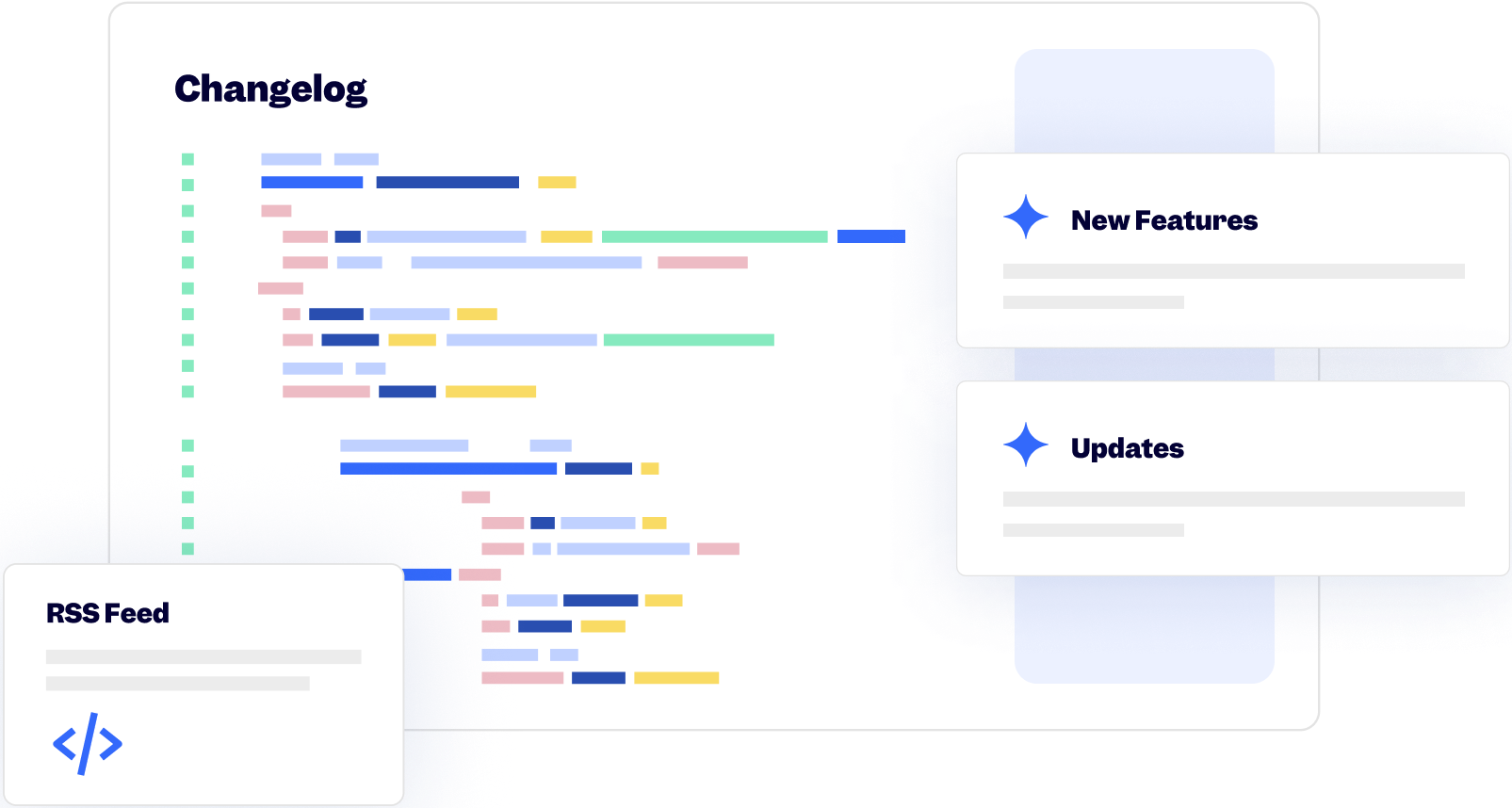20 August 2024
Published on 2024-08-20
Based on feedback from Shopify we've made two updates to the app's navigation:
- You'll now see a homepage with metrics and onboarding information when you first open up the app
- The 'Product rules' and 'Recurring edits' menu items have been merged under a single 'Automations' item
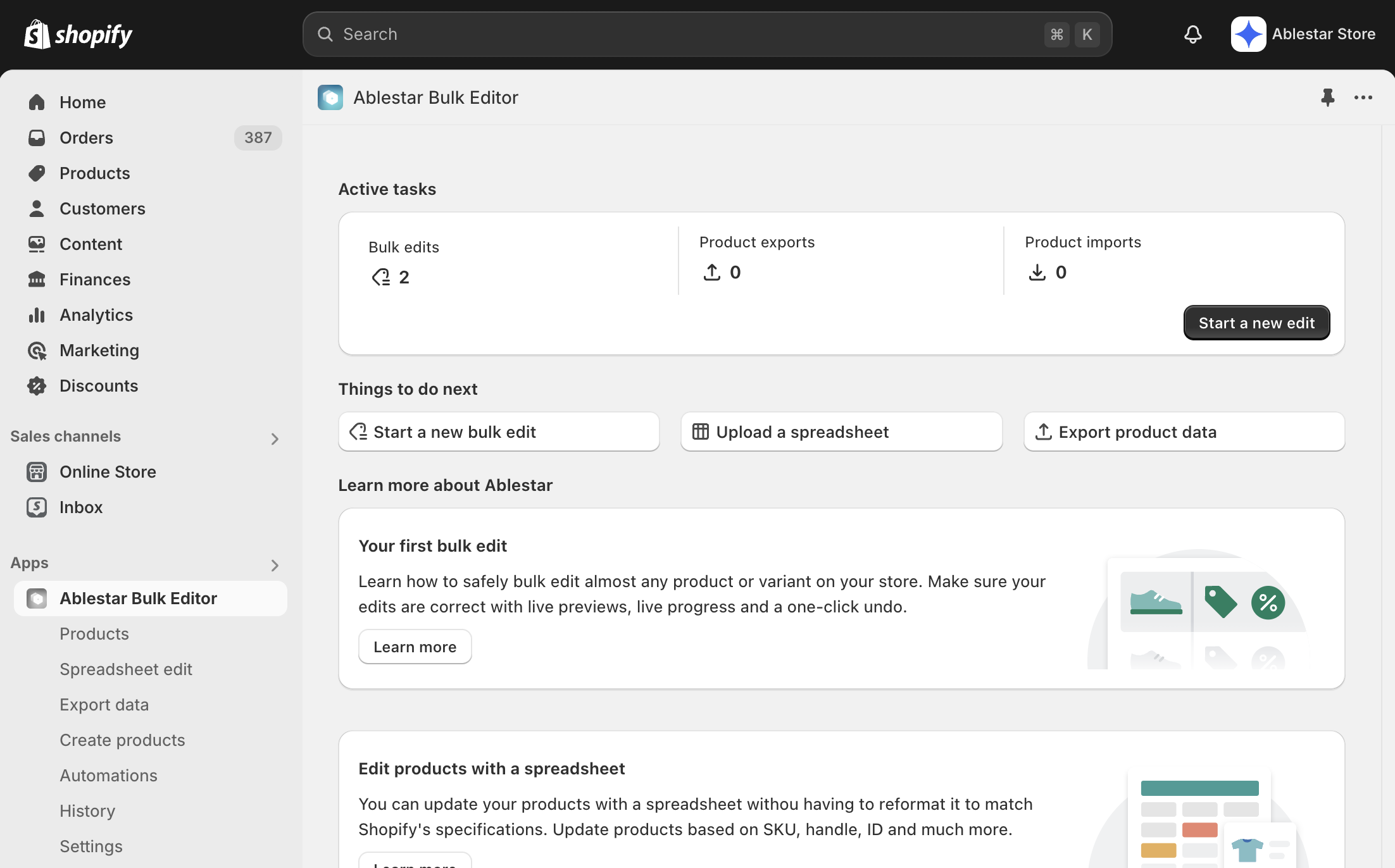
If you'd like to continue to go straight to the Product list page when you open up the you can toggle that feature by:
- Go to Settings → Integrations and features
- Turn on the 'Open to products page' feature
Please let us know if you have any feedback on the new homepage or additional information that would be helpful to see on the homepage.
6 August 2024
Published on 2024-08-06
We've added an option to the 'Add filter' dropdown to make it easier to search for products where the cost field isn't (or is) set:

See more search tips for Ablestar Bulk Product Editor
26 July 2024
Published on 2024-07-26
Now wildcard redirects will preserve URL query parameters through the redirect. For example, if there's a wildcard redirect setup for:
/p/* → /products/*
A visitor to the wildcard redirect would be redirected like so:
https://myshopify.com/p/summer-hat?promo_code=SUMMER2024 → https://myshopify.com/products/summer-hat?promo_code=SUMMER2024
Preserving the values in the URL that come after the question mark can help for user attribution or for promotions.
Learn more about wildcard redirects in Shopify.
25 July 2024
Published on 2024-07-25
We've made it easier to see which variants you're editing for a product. Now, if you add a variant-level filter (like price or option 1 value) you'll see the number of variants selected in the search results. You can also click on the eye icon to see a list of each variant.
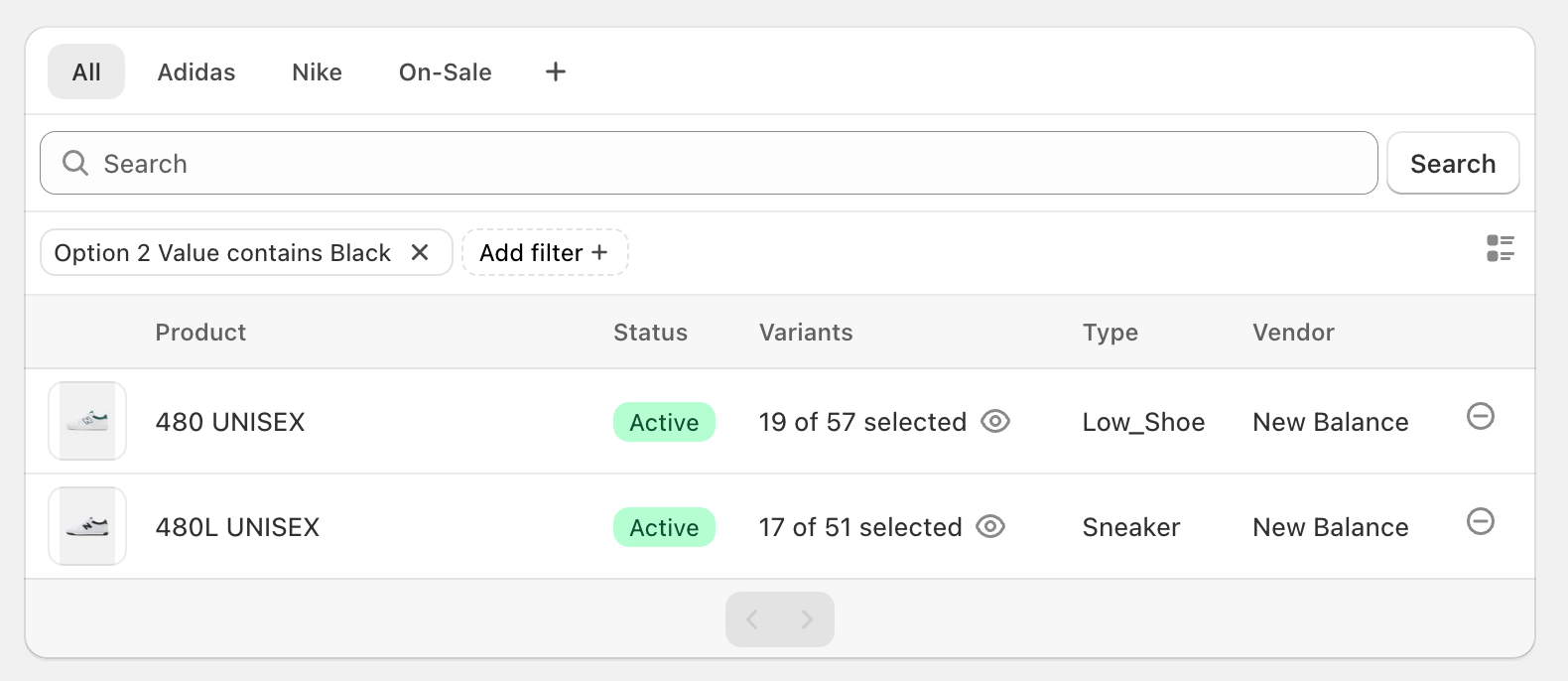
It's always been possible to edit only some variants of a product but this will make it more clear which variants are being edited before you go to the 'Configure modifications' and see the preview of your edit.
25 July 2024
Published on 2024-07-25
You can now bulk edit variants for a product directly from the Shopify admin. When you're looking at a product in the admin, click on the Bulk edit variants link to open up Ablestar Bulk Product Editor. When the app opens it will have all the variants for the product selected. You can optionally filter for a subset of variants and then bulk edit them.
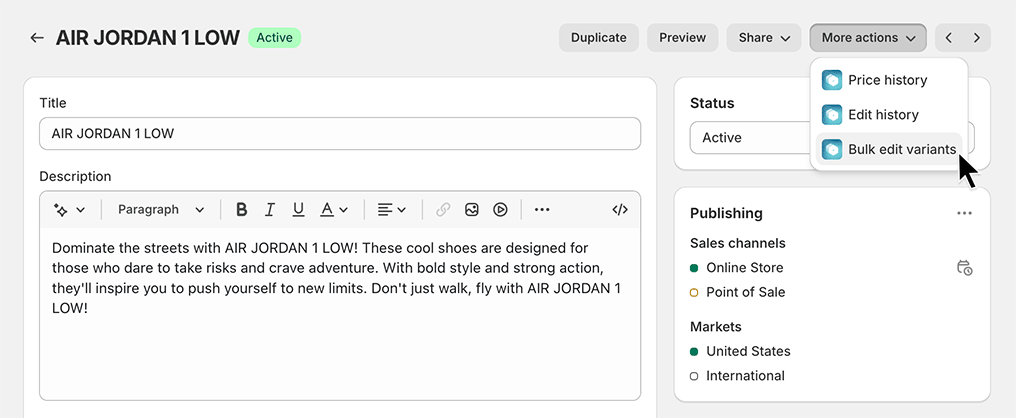
Learn more about bulk editing variants for a single product.
23 July 2024
Published on 2024-07-23
You can now copy and paste of list of product IDs to quickly select those products in Ablestar Bulk Product Editor. Just copy the cells from your spreadsheet and add a filter for 'Product ID contains any of the IDs':
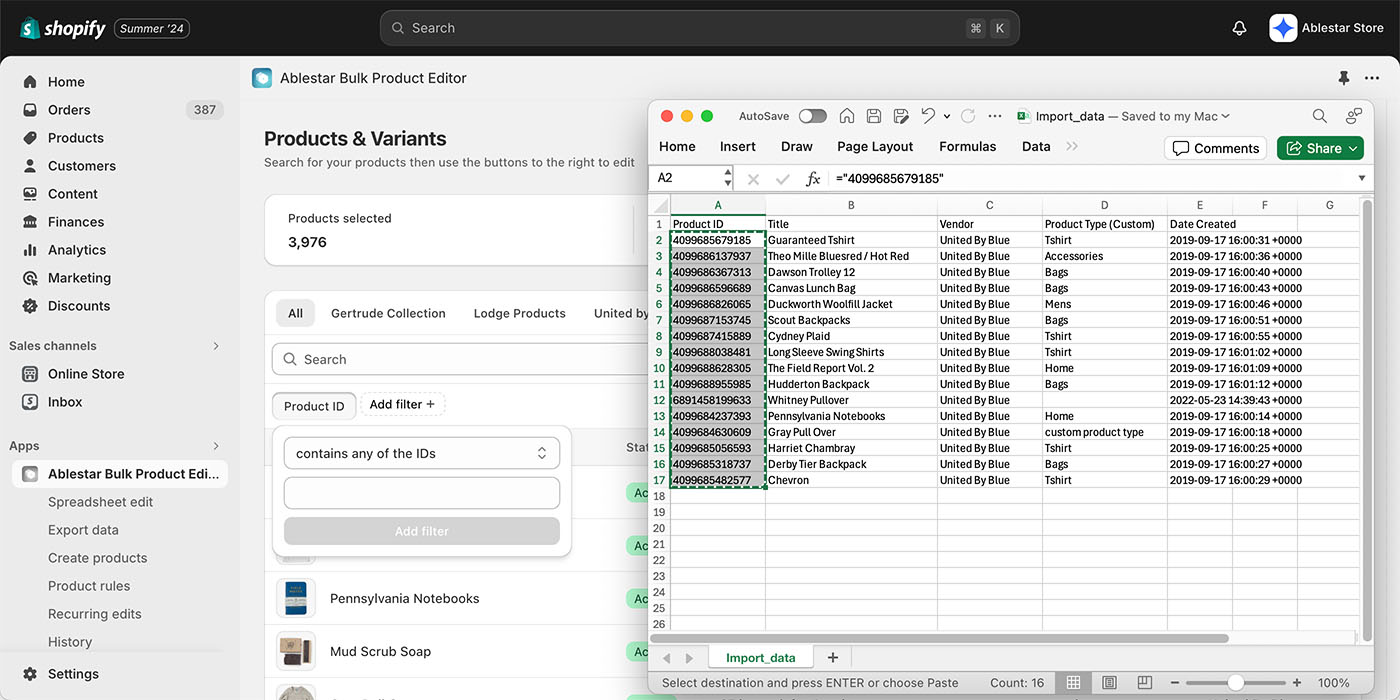
This way you can quickly edit or export a set of products that match arbitrary condition or that were sent to you by a supplier.
See more search tips in Ablestar Bulk Product Editor.
16 July 2024
Published on 2024-07-16
We've added a 'Primary Image' field to the product export section. Previously, when you exported product images to a spreadsheet you would see a column for each product image. With this new field you can choose to just see the first image for a product.
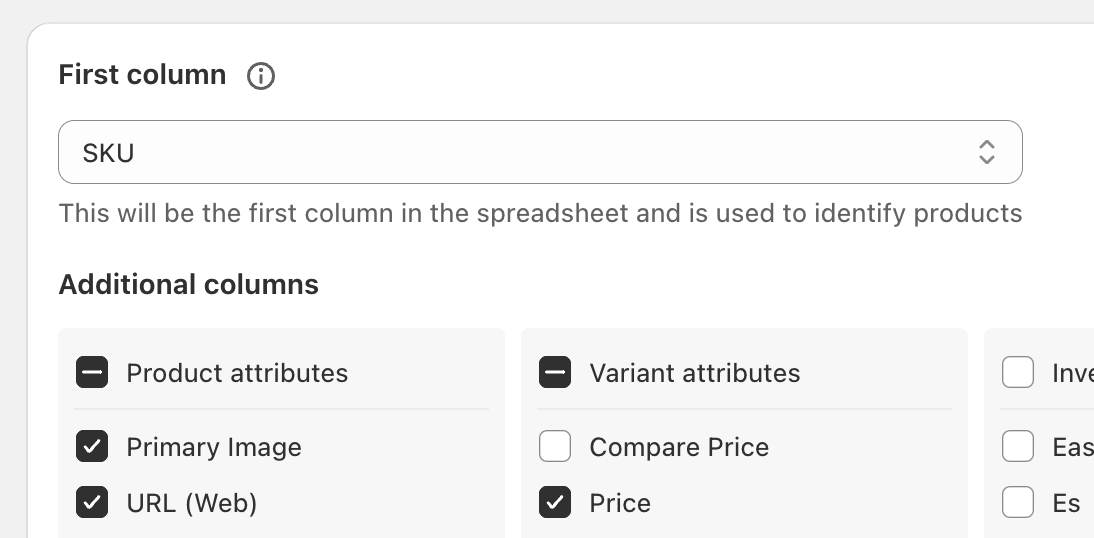
Learn more about exporting Shopify products to spreadsheets.
15 July 2024
Published on 2024-07-15
You can now use Ablestar Bulk Product Editor to update the ALT text for existing images using a spreadsheet edit. All you need is a spreadsheet where the first column specifies your product and the remaining columns are the ALT texts you want to update.
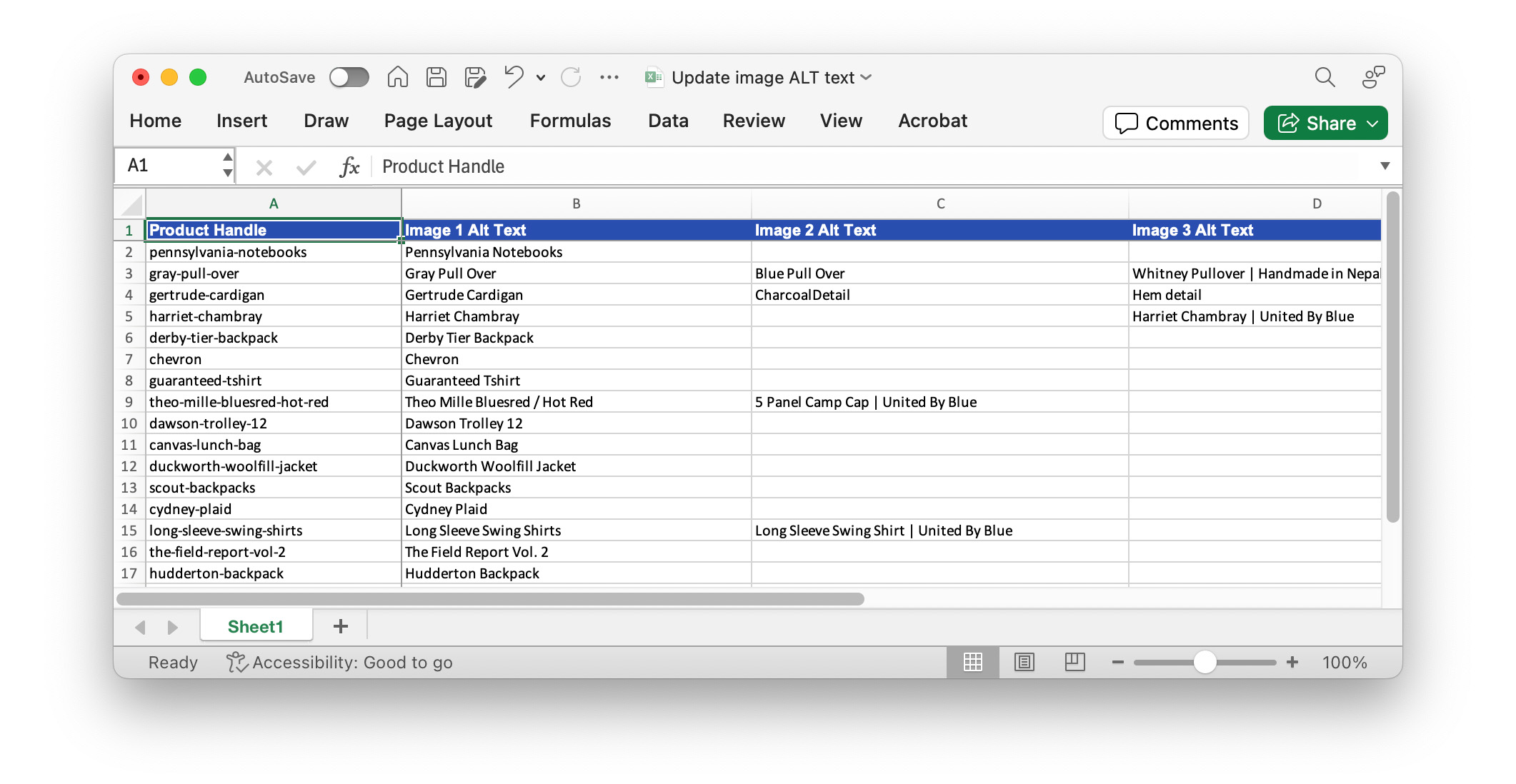
This should make it quicker to bulk update these fields to improve your images' SEO. Learn more about editing your products with a spreadsheet.
15 July 2024
Published on 2024-07-15
Starting today some users will notice that the app is now embedded directly within the Shopify admin. This will make the app faster and even quicker to use and is a result of months of hard work but our development team.
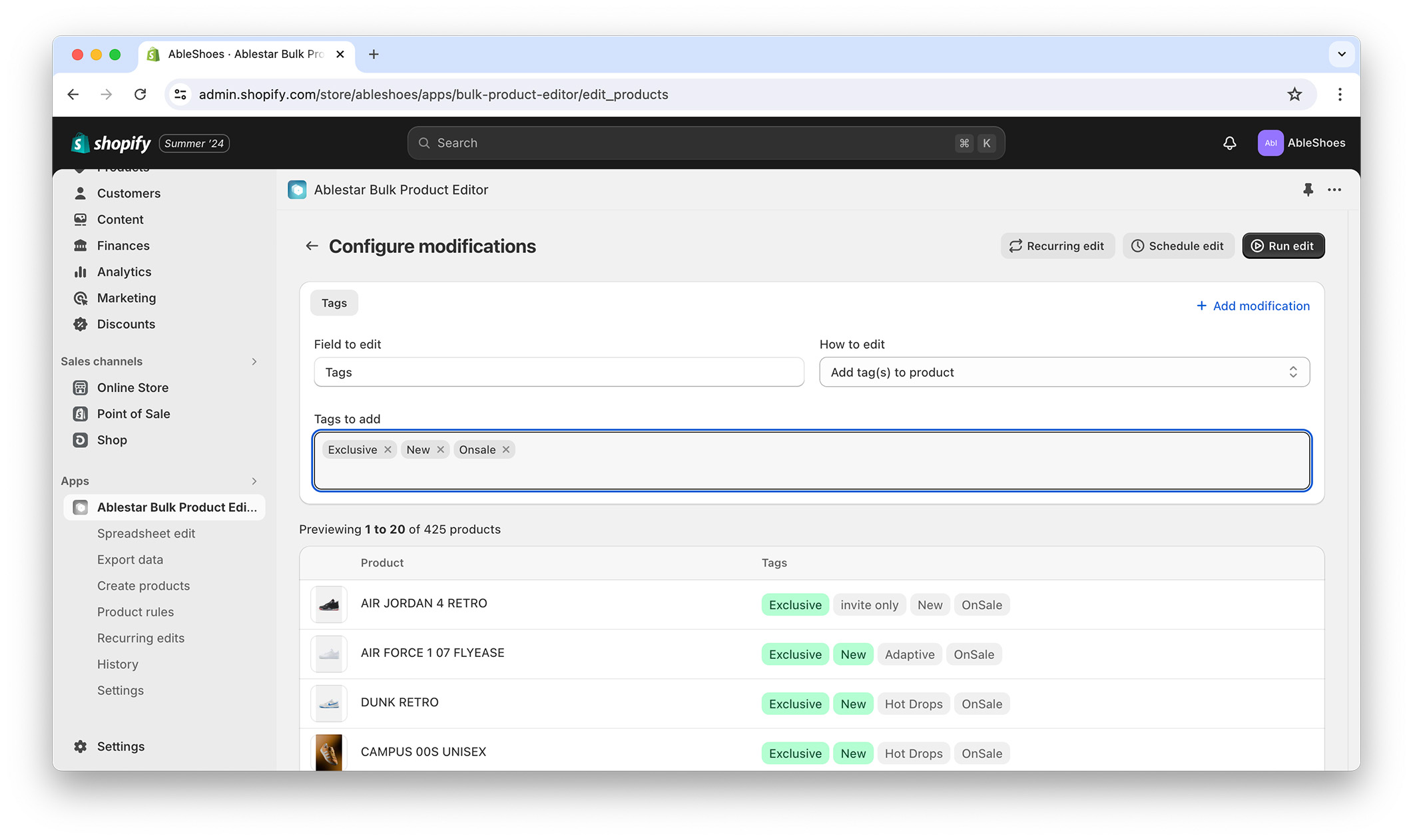
The changes will graudally be rolled out to stores in the coming weeks. If you have any feedback about the new embedded app please let us know.
12 July 2024
Published on 2024-07-12
We've added a "contains any of the words" filter for metafields. This allows you to quickly copy in a list of values and find products whose metafields match any of them:
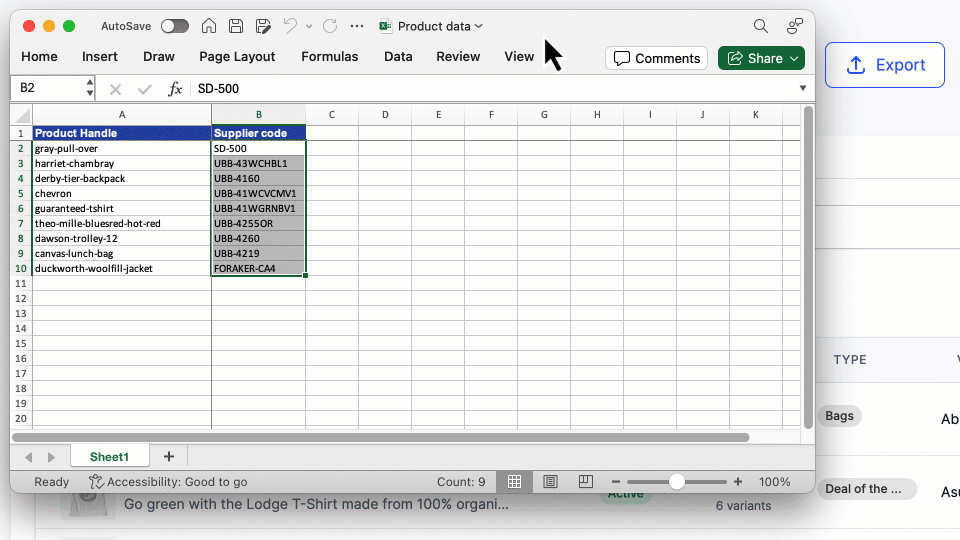
See more search tips in Ablestar Bulk Product Editor.
12 June 2024
Published on 2024-06-12
When you bulk edit a price or cost, you have the option to set the value to be a percentage of the compare-at price. Previously, if you tried to do this and there was no compare-at price set, the app would use the value of the price field instead. This was intended to make it easier to use but could lead to unexpected results.
Now, when you use the 'percentage of compare-at price' option on a variant where the compare-at price is blank or zero, the variant will not be edited, and you'll see an error message instead.
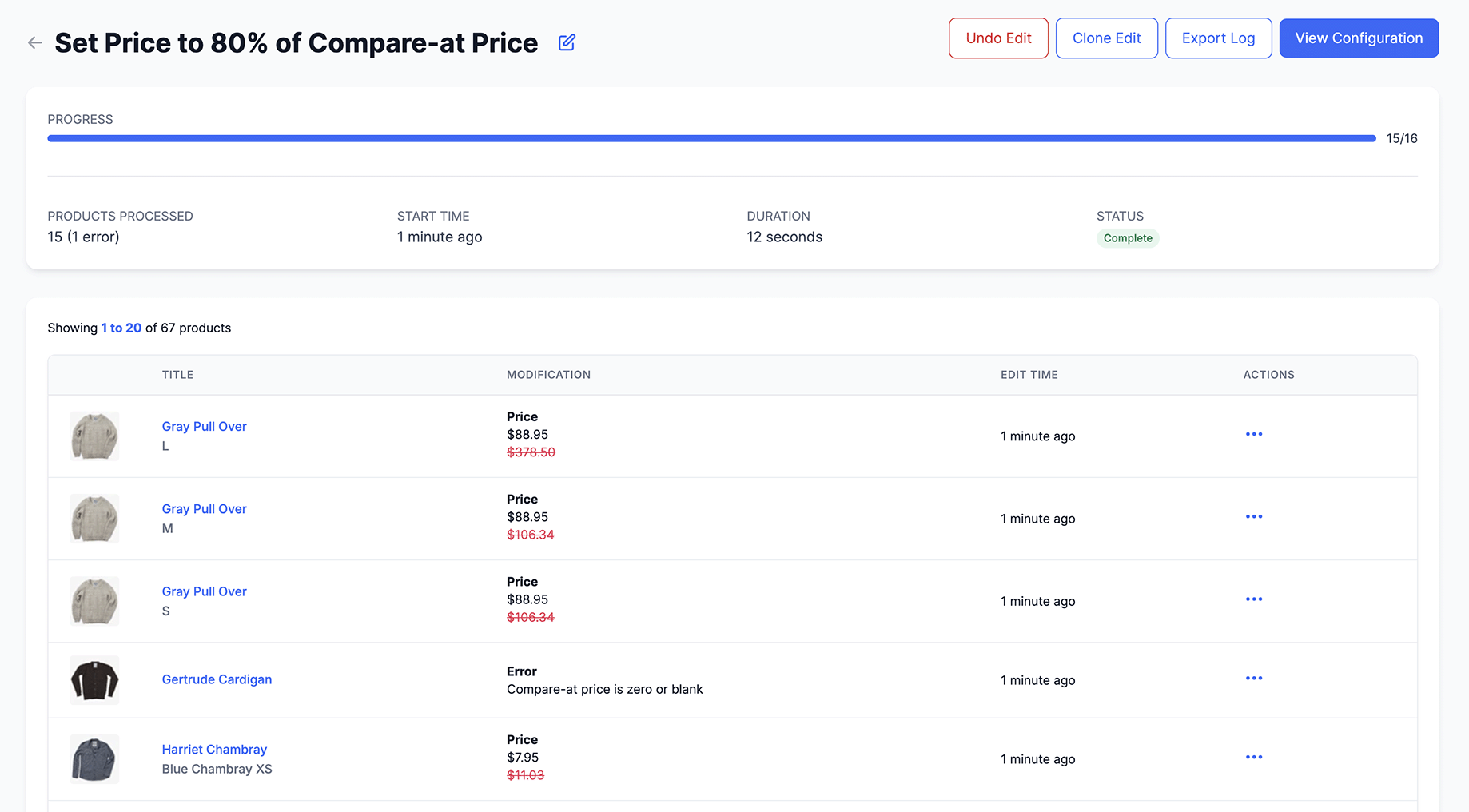
If you need to see a complete list of variants that had errors, you can use the Export Logs button on the edit detail page. Download the CSV file of all the edits and filter for errors.
Exposing these as errors should help uncover problems in your product's data and reduce the number of unexpected results with this edit type.
12 June 2024
Published on 2024-06-12
You can now export product image ALT text using Ablestar Bulk Product Editor. In the spreadsheets the image Alt text will appear in a separate column next to the image column.
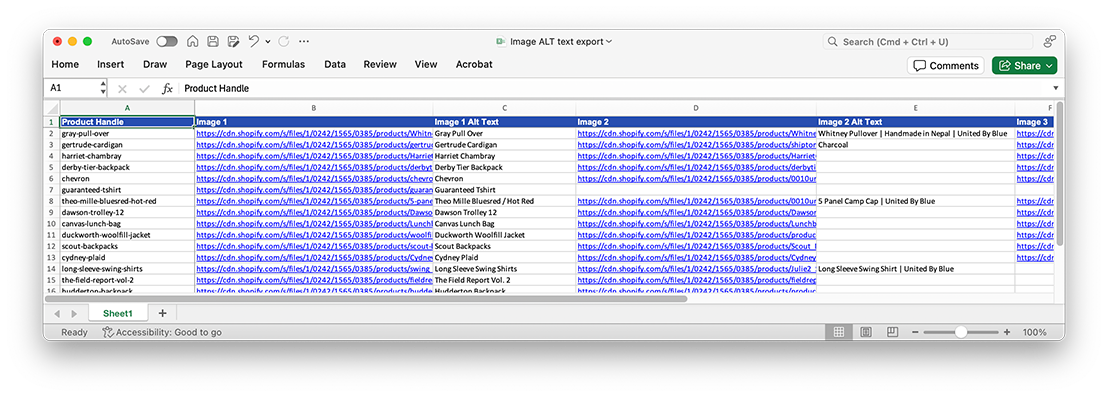
You can also use the Image ALT text column in spreadsheet edits to add new images to your products.
5 June 2024
Published on 2024-06-05
When a vistor lands on a page with a wildcard redirect they're seamlessly redirected to the new page. Now, you can see each time this happens in the app's dashboard.
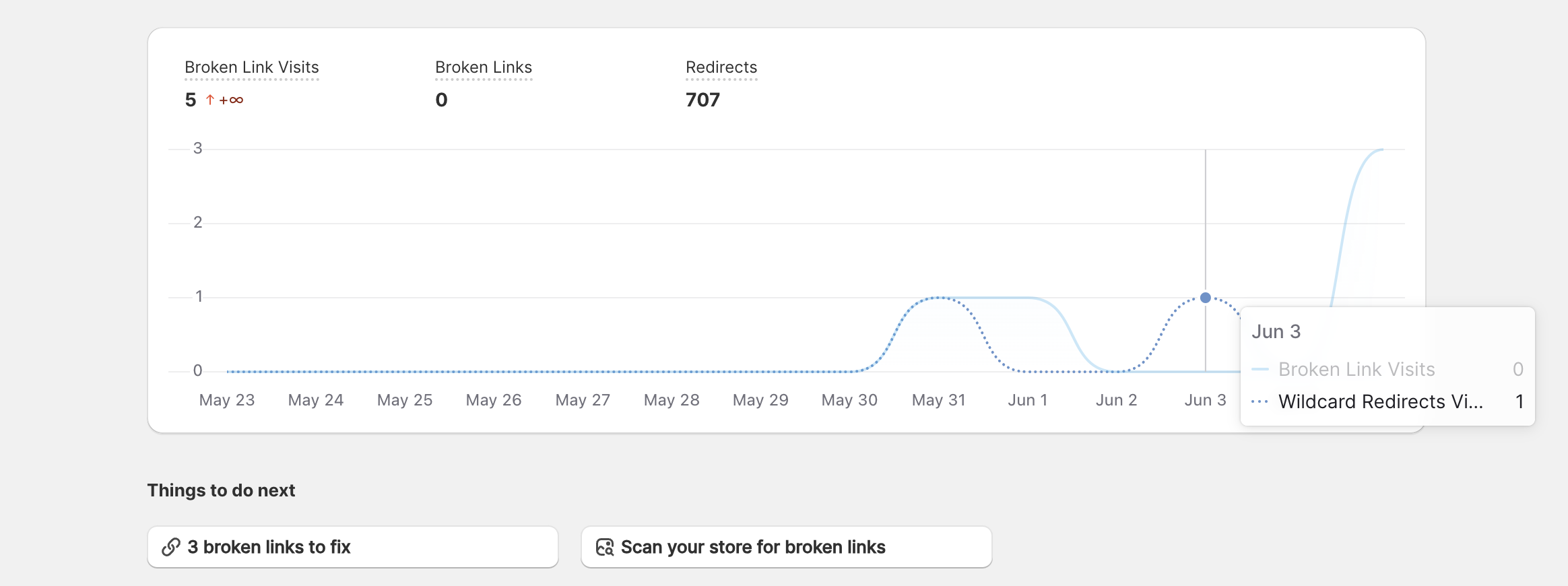
This data is also available when you export a spreadsheet of your wildcard redirect visits. This information can be especially useful if you've just migrated to Shopify because you can see the most frequent broken links, all the while ensuring your visitors get redirected to a relevant page.
Learn more about wildcard redirects for Shopify.
31 May 2024
Published on 2024-05-31
Now you can use product handles when exporting and importing product reference metafields. This will make it easier to see things visually and to transfer metafields between different stores (like a development and production one).
Previously product reference metafields were exported in the native Shopify format which looks like gid://shopify/Product/123456789 but now you will see the product's handle in the exported spreadsheet. This applies to metafields that are lists of product references as well.
For spreadsheet edits, the app will accept either product handles, or the values in the native Shopify format.
Learn more about bulk editing product reference metafields.
30 May 2024
Published on 2024-05-30
When you install Ablestar Bulk Product Editor you are shown a screen in the Shopify admin where you can grant the app permission to access specific parts of your store. We've added two new permissions that we need in order to support newer APIs: read_publications and write_publications.
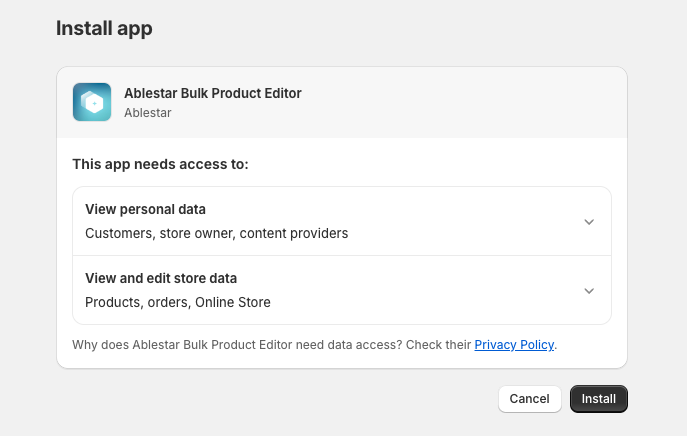
These permissions will allow us to continue supporting setting the visibility of products on Shopify POS through the app.
If you are the store owner, the next time you log in to the app you may be prompted to update these permissions. Staff and collaborator accounts will not be redirected because they might not have the permission to accept these access scopes on behalf of your store.
Learn more about the permissions required by Ablestar Bulk Product Editor.
22 May 2024
Published on 2024-05-22
You can use Ablestar Bulk Product Editor to modify the related and complimentary products in Shopify's Search & Discovery app. Now, this option is listed in the Integrations section of the app. In order to enable or disable this integration navigate to Settings -> Integrations and click on the toggle next to 'Shopify Search & Discovery'.

Enabling the integration will result in a reload of the app and then you should see the options in the field selector when configuring your edits.
Learn more about bulk editing Shopify Search & Discovery fields.bulk editing Shopify Search & Discovery fields
20 May 2024
Published on 2024-05-20
You can now automatically create URL redirects when bulk editing your Shopify product handles. Used with placeholders, this can be an easy way to update your product URLs to match your titles, all the while maintaining your SEO.
This change is being gradually rolled out to stores over the next few weeks. Please contact us if you would like it enabled sooner.
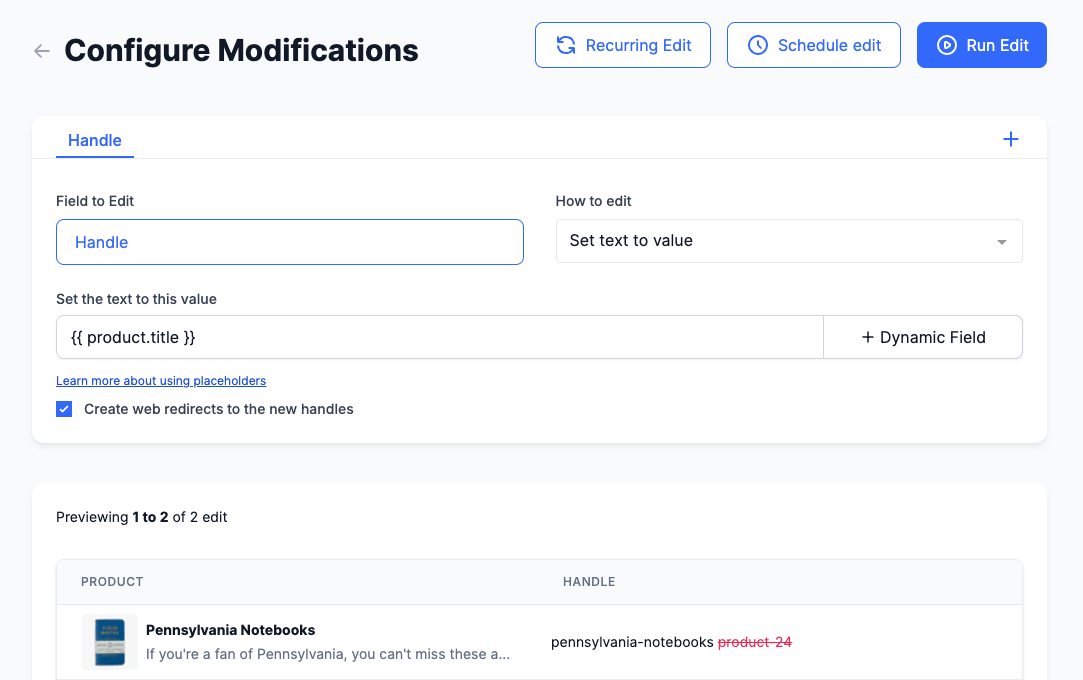
Learn more about matching Shopify product URLs to titles.
20 May 2024
Published on 2024-05-20
Over the next few week we will be migrating all stores to use Shopify's GraphQL APIs to handle product data. This migration will allow the app to keep building on new Shopify features including the upcoming increases to the variant limits. This switch should be seamless for users and no action is required on your part.

This change involved a major rewrite of the app's code and we are closely monitoring our logs to ensure everything continues to run smoothly. If you do happen to encounter an issue with an edit please let us know and we will take a look right away.
17 May 2024
Published on 2024-05-17
You can now use placeholders in wildcard redirects. This allows you to redirect a URL like /store/[ANY TEXT] to /products/[ANY TEXT]. This can be especially useful for migrations when the structure of your URLs are changing to Shopify's format.
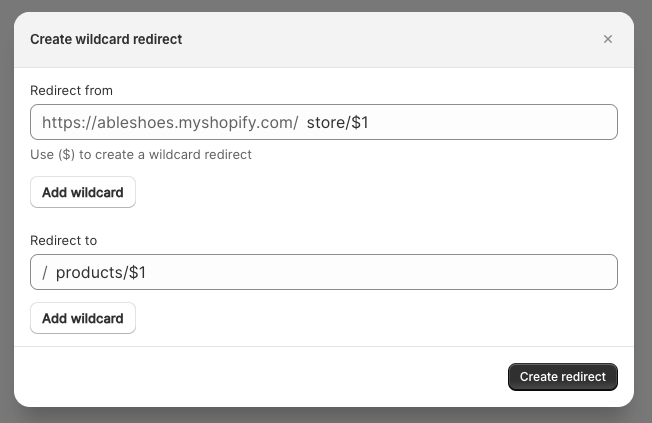
And as was the case before, wildcard redirects with Ablestar Link Manager do not a flicker of the '404 error page' like other apps could.
Learn more about wildcard redirects on Shopify.
14 May 2024
Published on 2024-05-14
After you run an edit you can download a detailed CSV file of the edit by clicking on the Export Log button. This CSV file will now include the time that the individual variant was modified and the time that modification was undone (if available).
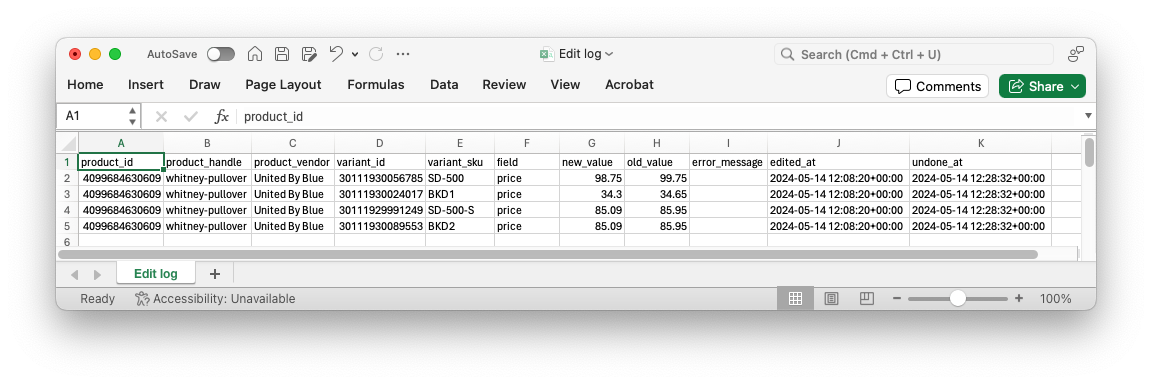 This will give you more visibility into exactly when a product was modified and make it easier to track down unexepected changes to product data.
This will give you more visibility into exactly when a product was modified and make it easier to track down unexepected changes to product data.

